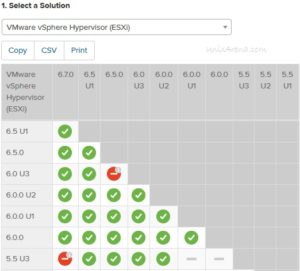


VGPU allows you to carve up a physical GPU into multiple virtual GPUs that can be used by VMs. VMware is also stating that there are "phenomenal" performance improvements in vCenter operations per second, in reduction of memory usage and DRS-related operations. The Backup Scheduler tool ( Figure 3) can be accessed from the vCenter Server Appliance Management Interface (VAMI). The built-in backup tool in vSphere 6.7 offers more scheduling options for its VCSA backup tool than in vSphere 6.5. You can also read my article about migrating from a Windows-based vCenter Server to a VCSA, as well as another article on using the built-in VCSA backup tool. As a side note, the VCSA can easily be monitored using vimtop (be sure to read my recent articles on using vimtop). Furthermore, the VCSA is very easy to update, and the Linux OS (Photon OS) is rock solid. Overall, I have found that the VCSA embedded database (PostgreSQL) performs great. Now that the vCenter Server Appliance (VCSA) is functionally equivalent to the Windows-based vCenter Server, it would take a lot to convince me to use the Windows-based one instead of VCSA. I wrote an article on the vSphere Client when it first came out that explains why VMware is switching to an HTML5-based client. Although the new client looks cleaner, and does seem more responsive than the vSphere Web Client, the location of some items has changed and some workflows will have to be adjusted accordingly with these changes. In vSphere 6.5, VMware had a list of the functionalities not yet supported in the vSphere Client hopefully the company will do the same for vSphere 6.7.įigure 1 shows the main menu of the vSphere Web Client, and Figure 2 shows the main vSphere Client menu. It looks like the vSphere Client can do about 90 percent that the vSphere Web Client can do. vSphere 6.7 further extends the capabilities of the vSphere Client and will eventually replace the vSphere Web Client. Also introduced in version 6.5 was the vSphere Client, which replaced Flash with HTML5.
#VMWARE ESXI 6.7 VS 6.5 WINDOWS#
VSphere 6.5 eliminated the vSphere Client that ran natively on Windows (also known as the C# Client or Thin Client) in favor of the vSphere Web Client, which was Flash-based. VMware has increased some of the other maximums. The most visible configuration maximum change in vSphere 6.7 is the number of devices that can be attached to a host.

#VMWARE ESXI 6.7 VS 6.5 DRIVERS#
This feature is only available with platforms and drivers that are on the Quick Boot whitelist, which is currently quite limited. vSphere 6.7, on the other hand, allows you to do a "quick boot" where it loads vSphere ESXi without restarting the hardware because it only restarts the kernel. Prior to vSphere 6.7, major version upgrades took quite a while (although they could be done without disruption by transferring workloads by using the Distributed Resource Scheduler ). VSphere upgrades can now be completed with one single reboot. If you're thinking about running this release on an older system for development or testing first before placing it into production on your newer servers, make sure to check the HCL to ensure compatibility. Following are some of the most important changes included with vSphere 6.7.Īn important hardware caveat to be aware of is VMware has released an HCL for vSphere 6.7 that excludes some older, yet popular CPUs. Despite the fact that a lot of new features were baked into the 6.5 release, this release does make some nice incremental changes. The vSphere 6.7 beta, though NDA-constrained, has been available to the public since October 2017. is not content to let its hypervisor become a commodity, and that it's possible to make incremental, evolutionary changes to a proven product and, moreover, that VMware is still making substantial investments in its hypervisor.
#VMWARE ESXI 6.7 VS 6.5 UPDATE#
VSphere 6.7, released today, includes an update to both its hypervisor (ESXi 6.7) and management console (vCenter Server 6.7).


 0 kommentar(er)
0 kommentar(er)
